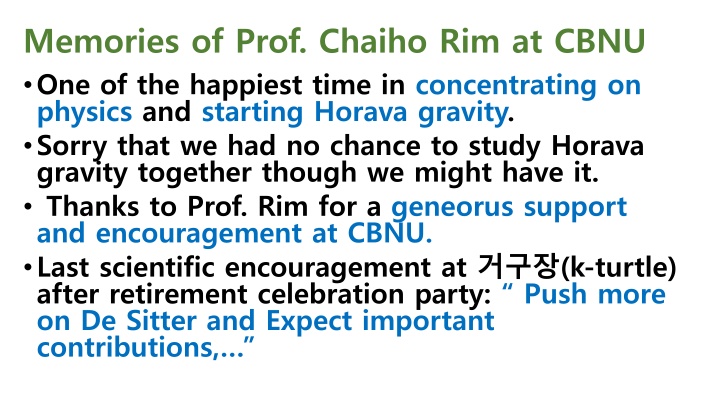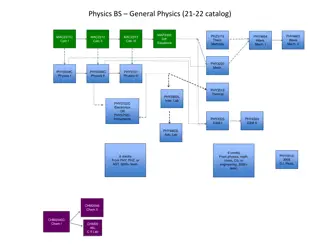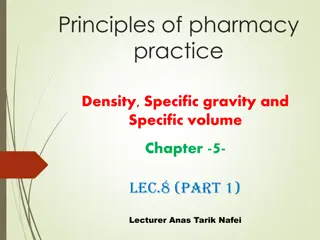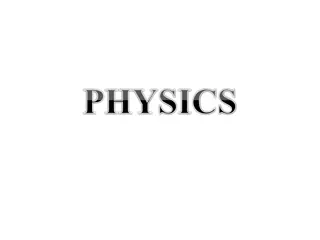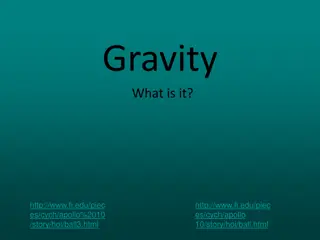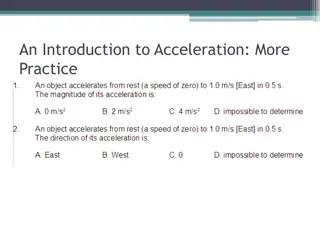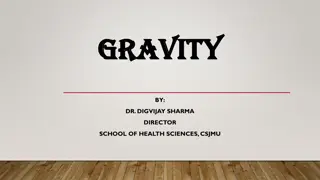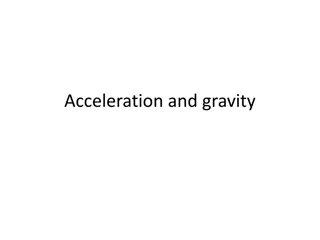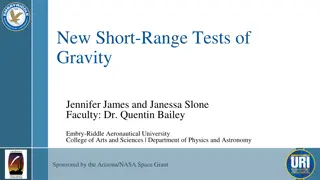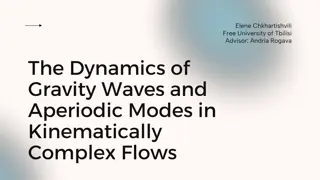Memories of Prof. Chaiho Rim: A Time of Physics and Horava Gravity
Memories of collaboration at CBNU, scientific contributions in higher-curvature gravities, challenges in understanding black hole interiors, and doubts on Cauchy horizons. Recent work includes the absence of an inner Cauchy horizon theorem and surprising results in scalar hair theories.
Download Presentation

Please find below an Image/Link to download the presentation.
The content on the website is provided AS IS for your information and personal use only. It may not be sold, licensed, or shared on other websites without obtaining consent from the author.If you encounter any issues during the download, it is possible that the publisher has removed the file from their server.
You are allowed to download the files provided on this website for personal or commercial use, subject to the condition that they are used lawfully. All files are the property of their respective owners.
The content on the website is provided AS IS for your information and personal use only. It may not be sold, licensed, or shared on other websites without obtaining consent from the author.
E N D
Presentation Transcript
Memories of Prof. Chaiho Rim at CBNU One of the happiest time in concentrating on physics and starting Horava gravity. Sorry that we had no chance to study Horava gravity together though we might have it. Thanks to Prof. Rim for a geneorus support and encouragement at CBNU. Last scientific encouragement at (k-turtle) after retirement celebration party: Push more on De Sitter and Expect important contributions,
CQUeST 2023 (Aug. 01, 2023) On No Scalar-Haired Cauchy Horizon Theorem in Higher- Curvature Gravities: An Introduction. Mu-In Park (CQUeST/Sogang U.) Collaboration with Deniz O. Devecioglu (CQUeST) Phys.Lett.B 829 (2022) 137107; arXiv:2307.10532 [hep-th]
Black Holes Do Exist in Nature ! LIGO 15 Figure caption
LIGO/VIRGO 20 EHT 17
Black Hole Interior is not well understood yet! 1. There is a (space-like) singularity (Penrose): Is this the end of physics ?
2. There is a Cauchy horizon (RN, Kerr) and time-like singularity
Doubts on Cauchy Horizon (CH) 1. Lack of predictability in GR beyond CH ? 2. Singularity can be seen by a time-like observer ? 3. CTC (closed time-like curve/Time Travel) for Kerr, rotating BTZ, Resolutions ? 1. Unstable CH 2. CH never forms, instead singularities form.
No Inner (Cauchy) Horizon Theorem 2. Hartnoll, Horowitz, Krutho and Santos, arXiv:2008.12786 (Charged Black Hole(k=0), Charged Scalar Field) 3. Cai, Li, Yang, arXiv:2009.05520 (Charged Black Hole(k=0,1,-1), Charged Scalar Field) There exists No Inner Cauchy Horizon for k=0,1 and non-trivial (non-zero, finite) scalar hair. But it can exist for k=-1. [R+F^2+scalar]
I was surprised at 1. Simplicity of the proof. 2. Quite generic results: No dependence on the scalar potential Quite Far-reaching applicability !! (cf. Usual no hair proof)
So, I wanted to classify all possible extensions of the theorem. Originally, I thought that Higher-Curvature gravities should respect the theorem in some ways. For example, L=R+R^2+ can be considered as L =R+scalar+ Motivated by this, we considered a Horndeski gravity with Einstein coupling to scalar and found that the theorem can be extended in that case, with a proper sign of the coupling constant [Devecioglu-Park arXiv:2101.10116 [PLB (2022)]]
Our result was the first higher-curvature gravity extension but with no higher- derivative initial data (second-order EQM)! As another higher-curvature gravity extension, we also considered Gauss- Bonnet gravity [R+scalar+f(scalar)GB], whose EQM remain second-order! [Devecioglu-Park arXiv: 2307.10532 [hep- th]]. (Details: Deniz s talk)
Plan I. Review of Cai, Li, Yang, arXiv:2009.05520 II. Extensions to Higher-Curvature Gravities.
I. Review of Cai, Li, Yang, arXiv:2009.05520 Consider Einstein-Maxwell-Scalar theory,
EOM Take an ansatz (static, isotropic), Phase field=0
Proof of No Inner-Horizon Theorem: Suppose two horizons, For a regular horizon (no singularity at the horizon), metric and matter fields should be smooth near the horizons.
For a charged scalar field (non-zero q): From the regularity at the horizons ( ) , we have two possibilities: (a): Non-trivial scalar field and finite (b): Trivial scalar field
Another key observation: (Radially) Conserved charge: Using EOM, one can find k=0: scale symmetry K=1,-1: Broken scale symmetry
Consider Q at the horizons Then, from we obtain From , we find
: LHS<0 RHS: Integrand is positive (i) RHS>0 for k=0,1 (No smooth Inner horizon) (ii) RHS<0 for k=-1 (Inner horizon is possible!)
No Scalar-haird Inner Horizon Theorem Power of Theorem: Far-reaching applicability due to no dependence on V. (cf. Usual no hair theorem) For k=-1, scalar-haird inner horizon is also possible. But, no exact (analytic) solutions are known and we need find numerical solutions to test the theorem explicitly. This is for charged scalar field. For neutral scalar field, we need an independent but the usual proof depending on potential. (see the paper).
Numerical solution for haired-Inner horizon k=-1, d=2 (3+1 dimensions), AdS
(i). Mass is tachyonic but above BF bound. (ii) No new singularity other than at the origin (z= )
II. Extensions to Higher-Curvature Gravities 1. Einstein-Maxwell-Horndeski Theories [DD&MIP, arXiv:2101.10116 [PLB (2022)]]
For a static ansatz (in the Schw. Coord) Phase field=0
From the regularity at the horizons, we have the same condition, for a non-trivial charged scalar hair, as Einstein gravity case, Radially conserved charge:
2. Einstein-Maxwell-Gauss-Bonnet-Scalar [DD&MIP, arXiv:2307.10532 [hep-th]] Static ansatz: Phase field=0
From the regularity at the horizons, we have the same condition for a non-trivial charged scalar hair, as Einstein gravity case, Radially conserved charge:
k=0: Theorem still works. k=1,-1: No simple condition for the theorem. But, we still have a general criterion for the existence haired-inner horizon, RHS>0 since LHS>0. To test the theorem, we need to find numerical solutions due to lack of exact solutions, as in Einstein gravity case.
Numerical solutions for scalar-haired Inner horizon (More details: Deniz s talk) Recover Einstein gravity case
No deep-interior (r<r_) solutions are found due to increasing errors at r_.
Radially conserved scaling charge: The general criterion works.
Our solutions are k=-1 cases and m^2<0 in AdS case, similar to Einstein case. For k=1 case, there is no Einstein gravity limit (no haired-inner horizon solution) and so, only the non-Einstein branch may exist: We need to search rather unusual solution space to find it. (cf1. Miok Park s talk) For k=0, the theorem says no-scalar haired solutions .
Perturbative solutions? At large r limit: Two groups of power for scalar: For r^-a power, we have reasonable iterative solutions. But for r^-2a, some inconsistencies occur!!?? A consistent expansion is not clear yet!
